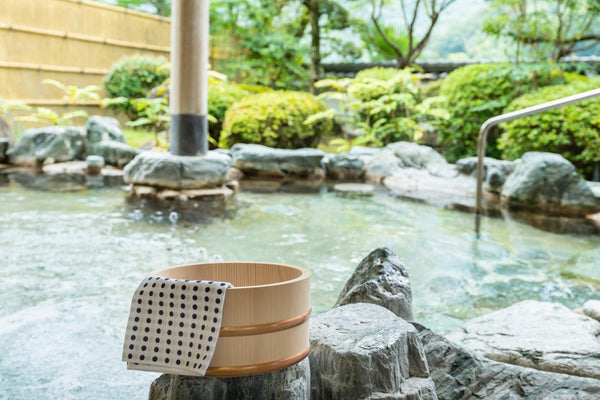
Jump to:
Hot springs, called onsen in Japanese, are an important part of Japanese society. Onsen are so important that they’re protected by law, have their own symbols on maps and are even used by some for medical treatment. Although people (and even animals) around the world enjoy hot springs, Japan has its own unique customs and traditions around them. This article will go into what onsen are, their history, some good ones to visit, and more.
What Is An Onsen?

An onsen is what most of us would call a “hot spring” or a “spa” in the West. According to the Japan Onsen Association, an onsen is “...hot water, mineral water, water vapor and other gas…” coming from the ground. To be considered an onsen, the water has to have a temperature of at least 77 degrees Fahrenheit (25 °C). It also has to contain at least one natural Japanese spa substance (for example, sulfur, iodine, fluoride). According to Shiraku onsen, “Japan currently has 3,133 hot spring resorts with lodging facilities, and a total of about 28,000 hot spring sources.”
History In Hot Water
Onsen have been popular in Japan since ancient times. They’re even written about in what is considered Japan’s oldest historical document — the 8th century book called the Kojjiki. According to the Japan Onsen Association, “In ancient times, it was difficult to make a fire to heat water and boil water. Hot springs, where warm water gushes out naturally without any intervention, are thought to have been extremely valuable and appreciated by people in the past.”
Onsen were also considered to have healing properties. In fact, the Nippon Communications Foundation says that in the Edo period (1603-1867) doctors were using onsen as medical treatment. Even into the current era, some people (including some scientists) believe Japanese hot springs have healing properties. Of course, the popularity of onsen today doesn’t revolve around only that. Now onsen are places to relax and spend time with friends and family, too.
What Can You Do At An Onsen?

Well, the first and most obvious thing you can do at an onsen is get in the hot water and soak, but there is a lot more you can try, too! Here are a few popular activities for onsen-goers.
- Sauna and Steam Room - Depending on the onsen you go to, there may be a sauna and/or steam room you can get into — like Fujiyama Onsen sauna in Yamanashi Prefecture (very near Mt. Fuji).
- Stay Overnight - Many onsen are set in a resort or ryokan (much like a hotel). These ryokan are usually very traditional with tatami mat floors. You will probably be provided with traditional Japanese clothing (like a yukata) to wear, too.
- Food - Onsen are often attached to resorts or ryokan that have restaurants. You can usually eat a variety of Japanese foods there (often traditional). Take a look at the menu at Kashiwaya Onsen in Gunma Prefecture to get an idea.
- Shopping - Most onsen have shops on location (or at least nearby) where you can buy souvenirs (omiyage). Here are some of Kusatsu Onsen’s gift shops — they have quite a variety.
- More Relaxation - There is usually a rest area where you can sit on a bench or sofa and read, talk, or watch TV. Some onsen have game rooms and even more specialized services like hot rock beds and massage.
Health Benefits Of Onsen

Onsen have some pretty obvious health benefits, including stress reduction and feeling less fatigued. But do the hot springs improve your health in any other way? Can they really make your skin better, cure diseases, etc. as you sometimes hear people claim? Well, going by a couple of scientific studies — yes, they can. Note: This article isn’t providing medical advice. Please take it with a grain of onsen salt.
Researchers from Beppu Hospital at Kyushu University reported, “...onsen bathing in the evening hours is linked to lower prevalence of hypertension in Japanese adults over 65.” The same university (they apparently have a huge interest in hot springs) released findings in 2021 that gout and irritable bowel syndrome were reduced by about 10% in men using onsen. “Likewise, risks of liver diseases were also down by 10% or more for men taking sulfur hot spring baths. Women who used simple onsen baths reduced their risk of asthma and obesity by 10% or more.”
So, it seems that there has actually been scientific research to back up the claims that many people have made about the healing powers of onsen all along. If you’re interested in which onsen will help you with a particular condition.
How To Use The Onsen

Onsen etiquette isn’t too tricky once you know the basics. Here are some simple rules to remember that will keep you from feeling like the foreigner who has no clothes.
Before you get into the onsen:
- Get hydrated (drink water before you get into the hot water).
- Take off your clothes (including underwear or swimwear) — everything — and put them in your locker. There will usually be a key in the locker that you can take with you when you go into the water area. Most people put the key on their wrist — it has an elastic band made just for this purpose.
- You’ll probably receive both a small towel and a large towel. Leave the large towel in the locker and take the small towel with you. You can cover up a bit with it, too, if you’re feeling shy about baring everything.
- Sit down on the bath stool and wash your body thoroughly in the shower stalls near the bath with soap (and don’t forget to shampoo your hair). Other customers might be watching to see if you bathed, too, so don’t skip this step!
- Before you get in the water, fold the small towel and place it on top of your head (yes, it’s normal). You can also wrap it around your head if you prefer. The towel is not supposed to touch the water, because it is considered unclean.
When you get out of the onsen:
- Shower off (if you want to). Some people don’t want to wash off the elements of the onsen water.
- Dry off with your small towel a bit.
- Go back to your locker and dry off completely with your big towel.
- After getting dressed, feel free to use the dressing area’s hair dryer and other grooming products if you need them (skincare products, hair combs and brushes, cotton swabs, cotton pads, etc. may be provided).
- Drink some more water and perhaps some milk.
Milk: It Does A Warm Body Good
Wait, milk? Yes, drinking milk after going into the hot water is a tradition that started in the last century or so — and the history is a little complicated. For details take a look at the somewhat hilarious #JapaneseMilkStyle website, and don’t forget to drink your milk with your hand on your hip.
Finding An Onsen In Japan

On Japanese maps (even Google maps) you will see a little symbol that indicates where an onsen is located. And it looks just like a hot bath with steam coming off it. Rather than trying to describe the image, take a look at the symbol here. You may see this symbol on street signs or near onsen, as well.
Are Tattoos Okay At Onsen?
Well, unfortunately for many travelers, a lot of Japan’s onsen still don’t allow tattoos. But the good news is that some onsen do. You just have to do a little research to find the right ones. Check out this article on Fodor’s by a tattooed traveler who shares their onsen experience in Japan.
Hot Springs In Japan vs Other Countries

There are hot springs all over the world. In fact, this map from Nature Communications is fascinating if you want to see where they’re all located. Here are a few notable regions where hot springs are popular.
- Taiwan - Interestingly enough, Taiwanese hot spring culture has its roots in Japanese onsen culture. Getting into the hot springs wasn’t really a thing until Japan gained control of the country in the late 1800s.
- United States - Yes, the US has hot springs, too! Americans can be a little shy about taking it all off, but it depends on the person (and the rules of the hot spring). There are natural springs scattered across the country, and you can see a list of them all here.
- Middle East & Europe - Hammam (also known as Turkish baths) have a long history. Take a look at this Moroccan hammam to get an idea of how they work.
Onsen vs Sento

Well, first of all, what is a sento? According to the Tokyo Sento Association, “A sento was originally a public bathhouse for people that did not have a bath at home.” As you might imagine, most people do have their own bathtubs or showers now, yet sento remain popular. That’s probably because — much like onsen — they’re mainly used for relaxation these days (and sometimes for people who actually just want to bathe).
So how is the onsen different from the sento? They’re both hot water baths that you get into, right? Yes. But the major difference is the type of water they use. Almost always, onsen use natural spring water. And legally, they can only call themselves “onsen” if their water meets the protected onsen definition. Sento, on the other hand, generally use the same water that people have in their homes — aka tap water.
Onsen To Visit In Japan

There are thousands of onsen in Japan, so picking one might be a challenge. Something worth considering are the three famous onsen of Japan (called nihon sanmeisen) that Confucian scholar Razan Hayashi wrote about hundreds of years ago. Many say that these are still the best onsen in Japan.
- Kusatsu Onsen, Gunma - This onsen is one of the most unique and tranquil in the country. It’s famous for having the largest amount of flowing hot spring water in all of Japan— and it’s breathtaking. It also has free footbaths on the streets. It can be reached by train in about three and a half hours from Shinjuku Station in Tokyo.
- Arima Onsen, Kobe - This onsen town is often called the most famous in Japan. According to their website, “It is the oldest Onsen (hot spring) town in Japan, founded 1300 years ago.” One unique thing about this one is that geisha can be seen regularly.
- Gero Onsen, Gifu - According to the onsen’s site, there is a free open air bath here (although Japan Guide said it’s been converted into a footbath). Also, nearby you can visit Gassho Mura — “A gassho (thatched) village of 10 houses, transferred from Shirakawa-go and elsewhere to recreate the landscape of Japan as it once was.”
Onsen Eggs

An onsen egg (onsen tamago) is an egg cooked in hot spring water. Typically, people think of them as having the consistency of poached eggs, but in reality, tamago onsen vary in consistency. According to OhtaBookStand magazine, no one actually knows where onsen eggs got started. Also, they aren’t only eaten in Japan! You can find them in Iceland, New Zealand and even in the US (basically all countries with hot springs). If you’d like to try making onsen tamago yourself, take a look at our Gyudon with Onsen Tamago recipe.


0 comments